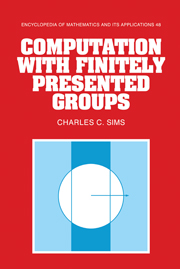Book contents
- Frontmatter
- Contents
- Preface
- Introduction
- 1 Basic concepts
- 2 Rewriting systems
- 3 Automata and rational languages
- 4 Subgroups of free products of cyclic groups
- 5 Coset enumeration
- 6 The Reidemeister-Schreier procedure
- 7 Generalized automata
- 8 Abelian groups
- 9 Polycyclic groups
- 10 Module bases
- 11 Quotient groups
- Appendix Implementation issues
- Bibliography
- Index
1 - Basic concepts
Published online by Cambridge University Press: 06 March 2010
- Frontmatter
- Contents
- Preface
- Introduction
- 1 Basic concepts
- 2 Rewriting systems
- 3 Automata and rational languages
- 4 Subgroups of free products of cyclic groups
- 5 Coset enumeration
- 6 The Reidemeister-Schreier procedure
- 7 Generalized automata
- 8 Abelian groups
- 9 Polycyclic groups
- 10 Module bases
- 11 Quotient groups
- Appendix Implementation issues
- Bibliography
- Index
Summary
It was not possible to make the exposition in this book self-contained and keep the book to a reasonable length. In a number of places, results from various parts of mathematics and theoretical computer science are stated without proof. This chapter reviews several of the most fundamental concepts with which the reader is assumed to be somewhat familiar. More material on sets, monoids, and groups can be found in algebra texts like [Sims 1984] and books on group theory such as [Hall 1959]. Two standard sources for topics in computer science are [Knuth 1973] and [Aho, Hopcroft, & Ullman 1974]. After a brief discussion of some concepts in set theory, we define monoids, summarize some important facts about groups, consider presentations of monoids and groups by generators and relations, contemplate some sobering facts about our ability to compute using presentations, agree upon a method for describing computational procedures, look at some basic algorithms for computing with integers, and study an important search technique. Readers to whom most of these topics are familiar may wish to proceed directly to Chapter 2 and refer back to this chapter as needed.
Set-theoretic preliminaries
The concept of a set is central to the formal exposition of mathematics. Despite the importance of set theory, most mathematics texts do not make explicit the axioms for set theory being used. Instead, they adopt a “naive” set theory based largely on intuition.
This book will be no exception. We shall assume that the reader has a basic understanding of sets and set membership, as well as the operations of union, intersection, and difference of sets.
Information
- Type
- Chapter
- Information
- Computation with Finitely Presented Groups , pp. 6 - 42Publisher: Cambridge University PressPrint publication year: 1994
